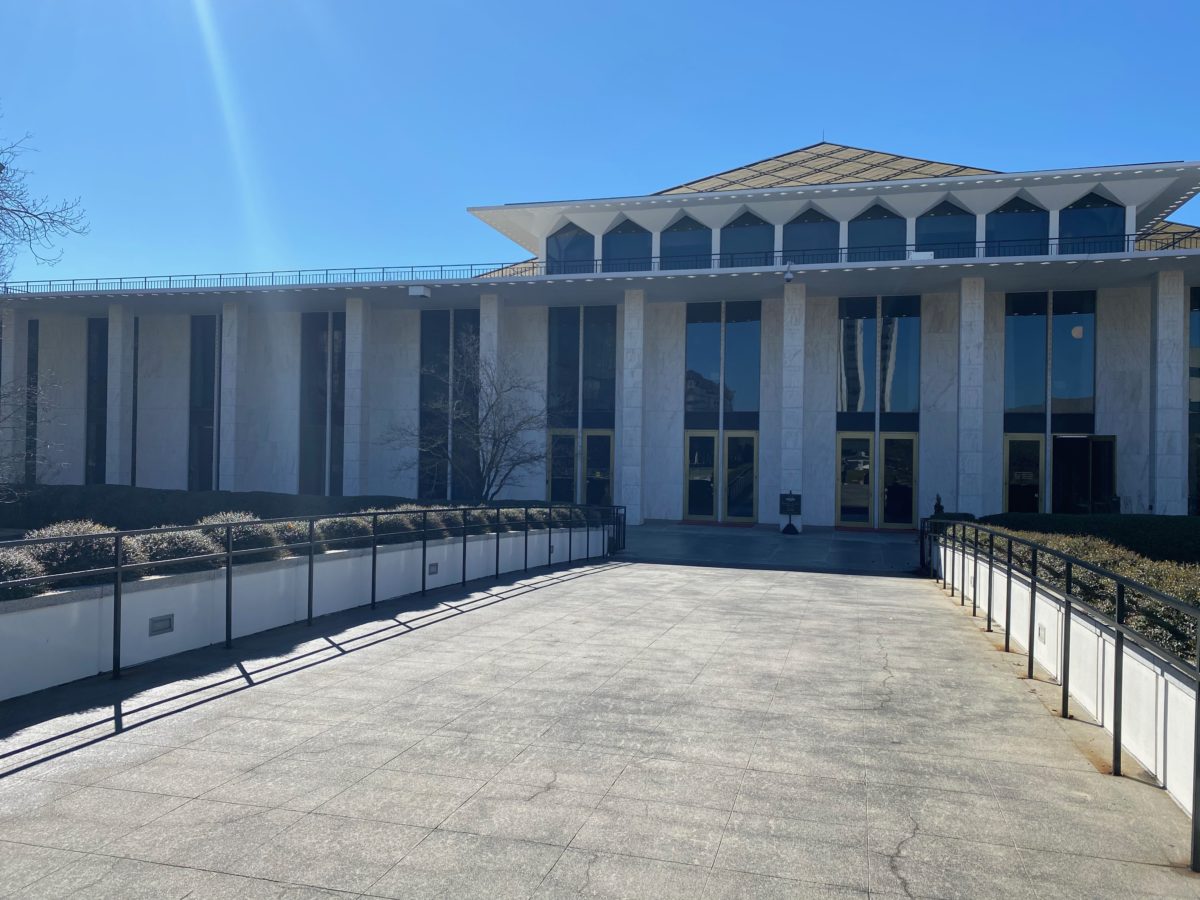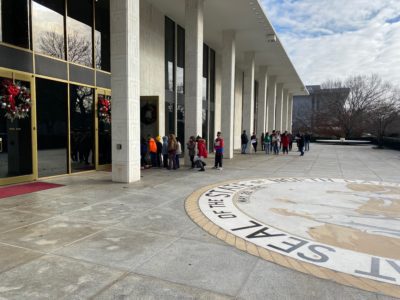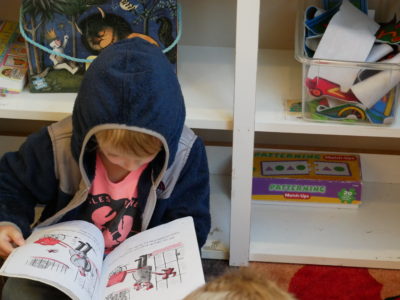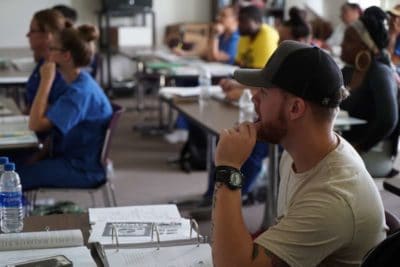

Share this story
|
|
Every year, policymakers and educators grapple to improve academic outcomes for students amid evidence of opportunity gaps for certain groups of students. The pursuit of viable solutions is especially urgent now, following challenges exacerbated by the pandemic.
In 2021-22, only 51% of students tested as grade-level proficient. If the state is to succeed in raising academic outcomes like grade-level proficiency, it will require making big gains for historically disadvantaged students. Those students are testing especially low in proficiency — at 33% for Black students, 40% for Hispanic students, and 35% for economically disadvantaged students.
And these outcome gaps, which follow access to opportunity gaps, are only growing after the pandemic.
The stakes are high for our students, and legislation will need to be evaluated through an equity lens.
But not all equity initiatives are created equally. The questions are threefold:
- What does equity mean to those making our laws?
- Will lawmakers advance legislation designed to foster equitable access to opportunities for each and every student?
- And, more specifically, will so-called culture war issues that dominated the last election cycle distract from ideas and plans rooted in research and designed to close opportunity gaps?
Based on the last legislative cycle, the midterm elections, and statements from lawmakers, we have a good idea of what proposals legislators are going to consider over the next two years.
Do we have agreement on the meaning of equity?
It’s not hard to find agreement among lawmakers and policymakers about the importance of education
The day after the midterm elections, Senate President Pro-Tempore Phil Berger, R-Rockingham, spent time talking about education — and equality.
“Without question, education is a great equalizer in a free society,” he said. “We fail in our most important task if we fail to recognize and act on that fact.”
According to data on things like academic performance, dropout and graduation rates, access to certified teachers, teacher diversity, and discipline, education is not equal for many Black and Brown, economically disadvantaged, and neurodiverse students.
That’s the difference in the messaging coming from the State Board of Education, which speaks to equity and addressing the reasons behind why things aren’t equalized already.
The State Board of Education defines educational equity as “the belief and practice of ensuring that every student is treated in a fair and just manner, providing the necessary allocation of resources for the success of every student, and eliminating discriminatory barriers to full participation and opportunities for every student.”
As lawmakers take up education issues this legislative session, we will be asking whether these measures advance equity, prove neutral, or worse.
What ideas are out there to advance equity in education?
Whether it’s school funding, diversifying the teacher workforce, addressing systemic failures for students with learning differences, or doing right by the state’s minority-serving institutions, there are several ideas that could be revisited this long session.
Equitable Funding and Leandro:
Funding education is a major function of the General Assembly.
The comprehensive remedial plan ordered as part of the long-running Leandro case is intended to address what the state Supreme Court called generations of failure to uphold its constitutional duty. The plan has provisions that would benefit students with disabilities, students experiencing racial discrimination, those living in socio-economic disadvantage, multi-lingual learners, and LGBTQ+ students.
Read more about EdNC’s coverage of Leandro here.
DRIVE Task Force and diversifying the teacher workforce
Gov. Roy Cooper established the Developing a Representative & Inclusive Vision for Education (DRIVE) Task Force when he signed Executive Order 113 in December 2019. The task force has held two statewide summits and has met regularly for three years.
In response to desegregation, an estimated 38,000 Black teachers across the South were fired and the number of Black teachers across the country decreased by 31.8%. In North Carolina, more than 3,000 Black teachers lost their jobs to white counterparts by 1972. The result was a majority white teacher workforce. As of 2019, 78% of teachers in the state were white, whereas 53% of students were nonwhite.
In 2020, the task force published a report on its recommendations to address the disparity.
Last session, House Bill 968 sought to enact these recommendations. The bill passed a first reading and sat for the remainder of the session in the rules committee. The DRIVE Task Force is continuing its efforts to advocate for its recommendations, and similar legislation could be coming this session.
The action plan includes things like investing in teacher cadet and grow-your-own-teacher programs, establishing professional communities for teachers to help them cope with the elevated demands of being teachers of color, and creating databases to track progress toward diversifying the teacher workforce.
The DRIVE Task Force is scheduled to meet at least four times this year, on Feb. 10, May 26, Sept. 22, and Nov. 17.
Doing better by students with disabilities
Parents of students with disabilities have decried the federal and state systems’ failure to appropriately educate their children. Last session, the state passed a law commissioning a study of North Carolina’s funding for exceptional children services that could help. This session, we could see those recommendations become law.
Nonprofit research company RTI International conducted the study and recommended the state move away from its flat, per-student funding model to a per-service model.
Sherry Thomas, the director of the Department of Public Instruction’s Exceptional Children’s (EC) Division, presented the report to the General Assembly during the short session last year, and both DPI and the Board are calling on the General Assembly to pass a law enacting its recommendations.
The General Assembly asked Thomas’s division to put together an estimate of what funding would look like if these changes are implemented. Thomas is using the December head count data that was recently certified and expects to provide estimates to the Joint Legislative Education Oversight Committee by the end of February.
The recommendation tracks some of the orders of the Leandro Plan, which supports a weighted approach to funding special education and removing the funding cap. The report recommends the state implement changes on a pilot basis and monitor the accuracy of service reporting.
The state currently provides a flat amount, $4,600, per student approved for EC services. Those funds are now capped so that a maximum of 13% of a district’s total student population is eligible. The cap was 12.5% three years ago.
The state identifies about 200,000 students as needing special education services, which is a little more than 13% of students. Of the state’s 115 school districts, 93 identify more than 13% of their students as needing special education services.
According to the report, 90% of the 99 public school units surveyed said they supported the service level approach, as opposed to one that is based on the type of disability a student has. By funding by tier of service, districts will be better able to purchase appropriate resources and provide specialized support.
Thomas told the Joint Legislative Education Oversight Committee that under the current model, students get the same funding “whether they receive 30 minutes of speech once a week or they are in a self-contained classroom with a nurse, with occupational therapy, with speech therapy.”
In the past, districts could offset higher expenses for a self-contained student by shifting money from a student with minimal needs. But about seven years ago, Thomas said she started seeing public schools lose students with less intensive needs to homeschools, private schools, and charter schools.
That trend continues to grow, she said, and leaves traditional public schools serving most of the exceptional children with greater funding needs. Enacting the recommendations from the RTI study is intended to increase funding.
“That is the whole purpose of this, is to more directly address the funding that is needed to provide the services required for those students,” Thomas said in an interview with EdNC. “And this flat funding cap does not meet that need any longer.”
Thomas said she’s heard some concern that the per-service model could lead to students being over-identified in more high-needs categories. The report says the research is inconclusive about whether this is occurring in other states that have adopted this model. Besides, Thomas said, districts are facing the opposite problem now.
“Most of the state complaints that we receive are not because students have been overidentified,” Thomas told JLEOC, “but (because) students have not been identified in a timely manner.”
In addition to revisiting the special education funding model, the General Assembly could reconsider a bill that makes it easier for families to appeal due process decisions directly to federal courts.
Last year, Senate Bill 593 received bipartisan support for allowing parties to immediately seek judicial review of an administrative law judge’s decision in a special education due process hearing by removing the step where the decision would first have to be appealed to the Board. Additionally, the bill would require the Board to enforce the final decision of the judge.
Cooper vetoed these provisions once they were added to a bill that replaced oversight of the Governor’s School for the Deaf and Blind by the Board with a committee of trustees appointed by the General Assembly.
Cooper’s statement on the veto made clear his objection was with the provisions related to the Schools for the Deaf and Blind.
Correcting chronic underfunding of HBCUs?
A Forbes investigation last year found nationwide underfunding of historically Black colleges and universities (HBCUs), and Democrats in the legislature are trying to reverse the trend. A recent example, which garnered national attention last year, was the General Assembly’s allocation of $8,200 less per student for N.C. A&T State University than it appropriated N.C. State University.
With House Bill 966, legislators in 2021 introduced a bill that would allocate additional funds to HBCUs and other minority-serving institutions to address present and historical underfunding. The bill also sought to establish an advisory board for historically minority-serving institutions.
A third facet – to include minority-serving institutions in the North Carolina Teaching Fellows Program – was rendered moot when the Teaching Fellows commission added Fayetteville State, N.C. A&T, and UNC-Pembroke.
The bill never made it out of the rules committee after passing first reading, but the state’s 10 accredited HBCUs are now working together — under the NC10 banner — and are expected to make another push to get similar legislation reintroduced.
Other bills to watch
Two bills that Republicans in the General Assembly introduced in 2021 may resurface.
Let’s take a look at each, and how they might impact equitable access to opportunities for students.
HB 324: ‘When you see progress, there’s always a backlash‘
House Bill 324, which the governor vetoed, was introduced in North Carolina as similar bills appeared across the country. It was entitled “Ensuring Dignity & Nondiscrimination/Schools,” and said that educators could not “promote” the following concepts:
- “One race or sex is inherently superior to another race or sex.
- “An individual, solely by virtue of his or her race or sex, is inherently racist, sexist, or oppressive, whether consciously or unconsciously.
- “An individual should be discriminated against or receive adverse treatment solely or partly because of his or her race or sex.
- “An individual’s moral character is necessarily determined by his or her race or sex.
- “An individual, solely by virtue of his or her race or sex, bears responsibility for actions committed in the past by other members of the same race or sex.
- “Any individual, solely by virtue of his or her race or sex, should feel discomfort, guilt, anguish, or any other form of psychological distress.
- “The belief that the United States is a meritocracy is racist or sexist or was created by members of a particular race or sex to oppress members of another race or sex.”
While the bill doesn’t mention critical race theory (CRT), legislators referenced CRT when the bill was introduced and throughout debate. CRT is a scholarly lens through which to study the ways in which systems and laws perpetuate discrimination. Young kids aren’t being taught to do this in schools, but they are being taught about history — which includes America’s history of discrimination and its effects.
But addressing that discrimination — and advancing equity — is becoming harder amid anti-CRT rhetoric, some educators say. Diversifying the teacher workforce, something that studies say would benefit all students (regardless of race), is one example. At this past year’s DRIVE Task Force Summit, educators followed discussions about the need to attract diverse educators with a discussion on the challenges.
“You’re trying to take this whole state somewhere that all members of the state don’t want to go,” said Jasmine Hill, an educator in Harnett County Schools. “I know discussing this at a boardroom in my district and a boardroom in Durham will look totally different.”
Nichole Richardson Ijames, principal of Challenger Early College High School in Catawba County, for example, pointed out that confederate flags fly in each of the four corners of her county. That makes it hard to woo and retain educators of color in the district.
It’s harder to confront issues like these right now, teachers said. Some educators fear for their safety — and beyond that, they don’t sense a welcoming or willing climate right now.
“One of the things that we saw emerge prior to the pandemic and during that first year was companies, school district officials, leaders were moving on a track for more equity work, more inclusion work, more diversity work,” elementary music teacher and North Carolina Association of Educators President Tamika Walker Kelly said at the October summit. “And when you see progress, there’s always a backlash. And right now we’re in the middle of a backlash.”
HB 755: How will a so-called Parents’ Bill of Rights impact students?
Legislative leaders indicated in a post-midterm election press conference that they expect to once again pursue a Parents’ Bill of Rights, which, among other things, would bar inclusion of sexual orientation and gender identity in the K-3 curriculum and require teachers and staff to notify a student’s parents if a student is questioning their sexual identity.
“Parents have made it clear that they are not happy with some of the things that are going on in our public schools,” Berger said.
Many of the comments by legislators when HB 755 was introduced focused on parents seeing things they didn’t like when their kids were learning from home. But groups like BCDI-Charlotte and the Education Justice Alliance in Raleigh have advocated for families of color who felt their voices weren’t being heard for many years prior to the pandemic. Other groups, like the ECAC and Disability Rights NC have fought for families of students with disabilities to be heard.
The timing of bills like this appearing across the country led ASCD, a national educational nonprofit focused on empowering educators, to publish a paper questioning bills like HB 755.
“Why is legislation needed?” it asks. “Are parental rights in fact being usurped by government agencies? Are there currently laws that undercut the role of parents in decision making regarding their children? And, critically, what is the likely result of proposals to create constitutionally based parental rights?”
It’s that last question that advocates who spoke against the bill during public comment after it was introduced honed in on.
“Everyone agrees parents should be involved in their children’s education,” Sen. Michael Garrett, D-Guilford said during floor debate. “However, I think this bill fails to live up to its promise in so many ways.”
The legislature kicks off in earnest this week. What did we miss? What are you looking out for this legislative session, and what questions do you have? Tweet us at @EducationNC.






